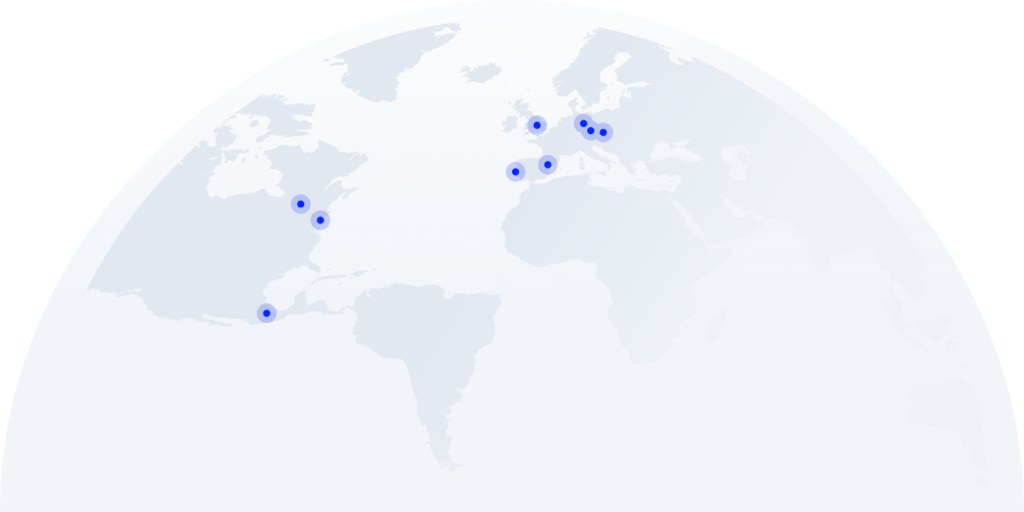
“Pricing not included” shouldn’t be the first thing you notice on a pricing page, right?
But that’s exactly what you’ll find with 8×8. The company removed all pricing from its website, leaving buyers to request a quote just to understand the basics.
Why go this route? Most likely, it’s a sales‑led strategy aimed at opening dialogue and upselling. But here’s the catch: 45% of B2B tech buyers say transparent pricing is the single most important factor when evaluating vendors1.
The lack of transparency stands in contrast to how far 8×8 has come. Once known for VoIP (Voice over Internet Protocol) hardware, it’s now a full-service provider of cloud-based UCaaS and contact center tools, with advanced routing, analytics, and AI add-ons.
In this guide, we’ll unpack 8×8’s current pricing model (what’s visible, what’s not), break down each available plan, and compare it to CloudTalk, an alternative designed for clarity, performance, and fast-growing teams.
Key Takeaways
- 8×8 currently promotes four distinct feature bundles (plans): Unified Communications, Contact Center, CX Beyond the Contact Center, and 8×8 for Microsoft Teams. Communications APIs are also available for developers.
- The legacy X2–X8 plan structure still exists behind the scenes and maps closely to the currently offered packages.
- According to user reviews, 8×8 pricing starts around $24/user/month, but full-featured omnichannel access can cost up to $140/user/month (before add-ons).
- Many essential call center features—like quality management, advanced analytics, or CRM integrations—are only included in top-tier plans or behind custom quotes.
- Compared to platforms like CloudTalk, 8×8 lacks transparency, makes global calling more expensive, and underdelivers on customer support.
Never used a business phone system? Our experts will show you how it changes your business…forever.
A Quick Overview of 8×8’s Plans & Pricing (Updated for 2025)
8×8’s pricing isn’t listed publicly anymore, and plan details can vary depending on what features or integrations you need. That can make comparisons a bit harder, but not impossible.
Below, you’ll find a clear breakdown of their current lineup, including what each plan includes, historical pricing benchmarks, and free trial availability.
Areas / Plan
Unified Comms (formerly X2/X4)
Contact Center (formerly X6)
CX Beyond the Contact Center (formerly X7/X8)
8×8 for Microsoft Teams
Annual Pricing
(user/month)
Available per request
(reviews report $24-$44)
Available per request
(reviews report $85)
Available per request
(reviews report $110-$140)
Custom quote available per request
Free Trial
30-day trial, limited features
Call Handling
Via Teams PBX
Call Queues
Available on select UC packages*
Via Teams Contact Center
Team Messaging
Native to Teams
Video Conference
Native to Teams
Call Monitoring
Available on select UC packages*
Limited via Teams
Skill-Based Routing
Callback
Call Center Analytics
Basic reporting only
Auto Dialers
Add-on
Integrations
Basic (Teams, Slack, Google)
Standard (CRM, helpdesk, calendar)
Full suite + advanced CRM/workflow automation
All UC/CC integrations (Teams-native)
Best for
SMBs starting with calling, chat, video
Growing support teams needing routing & analytics
Enterprise-level customer teams using AI + omnichannel
Organizations using Teams as a calling/contact hub
*Note: Some features (e.g., call queues and monitoring) were previously limited to the X4 plan and may only be included based on your contract, user count, or custom quote.
8×8 Unified Communications Plan
Plan overview:
8×8’s Unified Communications plan is their most accessible option, combining voice, video, messaging, and collaboration into one package.
It replaces the former 8×8 X2 and X4 tiers, and while it’s marketed as a simple call center solution for SMBs, what’s included can vary based on your contract or quote.
Best for:
The basic 8×8 tier is a decent choice for SMBs that are just starting their call center operations or looking for a basic cloud phone system with added collaboration features.
Pricing:
Although not publicly listed, users report a price range of $24-$44 per user/month (billed annually). Final cost depends on your feature set and seat count.
8×8 Contact Center Plan
Plan overview:
8×8’s Contact Center plan (previously known as the X6 plan) introduces real call center capabilities to the platform (routing, IVR, analytics, and supervisor features), making it a significant step up from UC-only plans.
Best for:
This plan is a good fit for mid-sized sales & customer support teams ready to move beyond basic voice, but not yet looking for full omnichannel or AI-enhanced workflows.
Pricing:
Based on user reports, pricing typically starts around $85 per user/month (billed annually). Final pricing varies depending on required add-ons and contract terms.
8×8 CX Beyond the Contact Center Plan
Plan overview:
This is 8×8’s most advanced plan, merging AI, omnichannel routing, analytics, and outbound automation into one premium offering. In a way, this plan consolidates what used to be the X7 and X8 tiers.
Best for:
The CX Beyond tier works well for large, multichannel support and sales teams that need advanced tools like auto dialers, sentiment analytics, and real-time QA insights.
Pricing:
Reported costs for this plan range from $110–$140 per user/month. Pricing is quote-based and often includes separate add-ons for full functionality.
8×8 for Microsoft Teams
Plan overview:
8×8 for Microsoft Teams isn’t a standalone plan. It’s rather an overlay that brings PSTN (Public Switched Telephone Network) calling and contact center features into Microsoft Teams. It allows users to manage calls, queues, and support workflows entirely within the Teams interface.
Best for:
This “crossover” plan is a practical option for companies deeply embedded in the Microsoft ecosystem and looking to extend Teams into a fully capable virtual phone system or contact center.
Pricing:
Pricing is available only by quote and depends on whether you’re layering Teams over a Unified Communications or Contact Center plan (the first two tiers). You’ll also have to pay for Microsoft Teams separately, so expect to budget for both platforms.
8×8 for Developers: Communications APIs
Don’t be confused. This plan isn’t mentioned in the 8×8 plan overview above, and there’s a simple reason for that.
8×8’s Communications APIs, part of its CPaaS (Communications Platform as a Service) offering, are meant for developers building custom communications workflows into their own products. Instead of a user-facing interface, this plan gives you direct programmatic access to features like voice calling, SMS, and video via REST APIs and WebRTC.
It’s completely decoupled from 8×8’s UCaaS and CCaaS platforms, making it ideal for apps and services that need embedded communications without a prebuilt dashboard or softphone.
Best for:
The “developers” plan is a strong fit for SaaS companies, platforms, and engineering teams that:
- Need to embed click-to-call, 2FA codes, alerts, or appointment reminders
- Want to build custom IVRs or messaging bots
- Prefer usage-based billing and don’t need per-seat licenses or bundled features
Pricing:
Pricing is usage-based (not per user) and depends on message volume, call duration, region, and media type. Voice, SMS, and video APIs are billed individually, with rates published via 8×8’s developer portal.
8×8 doesn’t let you test drive all features, but guess who does? CloudTalk, that’s right.
8×8 Key Hidden Fees You Should Know About
If you’ve ever tried getting a straight answer about 8×8 cost and plans, you know how quickly a simple quote turns into a series of follow-up emails, discovery calls, and custom offers.
That’s because 8×8 doesn’t publish its pricing or feature tiers online, and the quote you receive may not include everything you actually need.
This isn’t unusual for enterprise platforms. But for growing teams, it can mean unexpected costs cropping up well after implementation.
Here are the most common hidden fees and surcharges 8×8 users report:
- Training courses: Comprehensive onboarding and admin training can be added at an extra cost, as these aren’t included in base-tier quotes.
- International calling: “Unlimited” plans exclude mobile, premium, or international numbers. Calls to these destinations are billed separately.
- Calling limits: Unlimited minutes often exclude mobile or international premium lines.
- Call center plan surcharges: Features like outbound dialers and quality tools often require higher-tier plans or expensive add‑ons.
- Early termination fees: If you cancel before your contract ends, you could owe for the remainder of the contract, often $60–$200.
- Number provisioning fees: Vanity or toll‑free numbers can carry setup fees (~$5+ per number), depending on the selected plan.
- Mandatory platform fees: Teams overlay requires a separate license and Microsoft Teams subscription, so expect to pay more.
Tired of chasing quotes just to uncover the real cost? Our experts will show you everything upfront.
8 Essential Considerations Before Choosing 8×8
Before you commit to 8×8, it’s worth taking a closer look at the fine print. These eight factors are often overlooked, but they can impact your experience, budget, and long-term scalability.
Limited Integration Capabilities
8×8’s lower-tier Unified Communications plans only support basic integrations like Microsoft Teams, Google Workspace, and Slack.
If your team relies on platforms like Salesforce, Pipedrive, HubSpot, or Zendesk, you’ll either need to upgrade or request them as part of a custom quote, which adds both time and cost to deployment.
Clunky Call Recording
By default, call recordings are stored for just 30 days. Longer retention, cold storage, or quality management tools require extra purchases or a jump to higher-tier plans.
There’s also no central “smart” search across call transcripts unless you add 8×8 Speech Analytics.
Outdated User Interface
While 8×8 has refreshed parts of its dashboard, many users still report a dated, unintuitive experience, particularly when navigating call analytics, setting up new agents, or switching between UC and CC modules. This can slow down onboarding and daily operations.
Limited Texting Features
8×8 includes SMS and MMS support in higher-tier plans, but users on basic plans face limitations. SMS may be one-way only, lacks link previews, and often excludes MMS entirely, which can frustrate teams that rely on text for support or outreach.
Less Responsive Customer Support
User reviews frequently highlight slower ticket handling, long wait times on support calls, and inconsistent responses from the support team. This can be a problem if you’re running a high-volume call center and need urgent resolution for voice or routing issues.
Limited Plan Details
8×8 no longer publishes its pricing or plan breakdowns online. Everything is quote-based, and many basic features vary based on region, seat count, or contract. This makes it difficult to benchmark 8×8 against competitors like CloudTalk that offer full plan & pricing transparency.
Contract Flexibility & Early Exit Fees
Most 8×8 plans are sold on 12–36 month contracts. If you need to cancel early, you’ll likely face fees ranging from $60 to $200 per user, plus usage overages. These costs aren’t always disclosed upfront and can catch smaller businesses off guard.
Scalability for Growing Businesses
While 8×8 can handle large-scale enterprise needs, smaller teams may struggle to scale affordably. Many useful features—like auto dialers, quality scoring, or AI IVR—only unlock with add-ons or upgrades, making growth more expensive than expected.
The best way to avoid surprises? Start with a free trial that shows you everything upfront.
CloudTalk Vs. 8×8: Which Is the Best Choice for Your Business?
When choosing a provider, it’s important to look at their offering in the context of other options on the market. In this case, we’ll be comparing 8×8 against CloudTalk, so it’s vital we give you some context.
Short Overview of CloudTalk’s Plans and Pricing
CloudTalk has 4 pricing plans on offer, ranging in price from $25 to $50 per user/month, with a special exception for the custom pricing plan, which lets you tailor your solution to your unique business needs. Here’s a breakdown of CloudTalk’s plans:
- Starter: CloudTalk’s most basic plan, designed specifically for micro and small businesses. Easy to set up and easier to use, this plan offers small teams everything they need to kick off their call center operations.
Key Features: Click-to-Call, Voicemail, Call Flow Designer (CFD), Automatic Call Distribution (ACD)
Price: $25 per user/month - Essential: CloudTalk’s equivalent to RingCentral’s advanced plan, focused on growing SMBs and MMBs. This plan helps teams expand their inbound and outbound operations, automate processes, and improve experiences.
Key Features: SMS/MMS, Interactive Voice Response (IVR), Skill-Based Routing, Callback, Integrations + Open API
Price: $29 per user/month - Expert: CloudTalk’s feature-packed plan for growing MMBs and enterprises, or any team that requires robust calling capabilities. This plan helps customer-facing departments streamline outreach and improve performance.
Key Features: Power Dialer, Smart Dialer, VIP Queues, WhatsApp Inbound & Outbound Messages, Call Monitoring
Price: $49 per user/month - Custom: CloudTalk’s ultimate plan for the most demanding of companies, tailored perfectly to their particular business needs. This plan allows you to do it all, from coordinating teams to conquering the world’s many markets.
Key Features: Custom Onboarding, Unlimited Outbound Calls with Flat Rates, Enterprise-Level Security, Developer Support
Price: Varies based on features, number of users, etc.
CloudTalk Vs. 8×8: Direct Comparison
Aspect/Features
CloudTalk
8×8
Starting Price
From $25/user/month
$24 per user/month
Free Trial
14 days
Not available
35+ from Essential
($29 per user/month)
70+ from X2
(basic $24, advanced $110 per user/month)
Multichannel Features
From Expert
(SMS, WhatsApp,
$49 per user/month)
From X7
(SMS, Email, Social Media,
$110 per user/month)
Instant Messaging
Not available
From X2
($24 per user/month)
Conference Calls
From Essential
($29 per user/month)
From X2
($24 per user/month)
WhatsApp Integration
From Expert
($49 per user/month)
Add-On
($29 per user/month)
There are plenty of fish in the sea—why settle for the first one you hook?
CloudTalk vs 8×8: Key Takeaways
We can glean several insights based on our comparison between CloudTalk’s and 8×8’s pricing and plans that paint a clear picture of which competitor is the better option. These include:
- Pricing: While 8×8’s pricing starts at an affordable $24 per user/month, the subscription cost quickly balloon to a relatively high point for a VoIP provider. In comparison, CloudTalk’s full suite comes in at an affordable $69 per user/month.
- Features: While 8×8 benefits from offering a combined array of collaboration and multichannel tools, its call center features may be lacking. Meanwhile, CloudTalk offers a comprehensive VoIP toolset.
- Integrations: Although 8×8 has a broader integration ecosystem, their availability is a little confusing due to the unclear distinction between basic and premium integrations. All of CloudTalk’s integrations are available at just $30.
- International Numbers: CloudTalk offers a more extensive selection of international, toll-free, and local numbers, which are vital for growing companies with a global customer base.
Try CloudTalk’s Conversation Inteligence
8×8 Best Features
As we’ve discussed, 8×8’s packages are quite varied in terms of features and use cases. However, there are a few that rise above the rest. Based on online reviews and testimonials, 8×8’s top 3 best features include:
- Auto Dialer: 8×8 enhances outbound calling efficiency by offering preview, progressive, and predictive dialing modes. These modes automate the dialing process, increase connection rates, and enable faster agent handling, thereby boosting productivity.
- Omnichannel Capabilities: The platform supports omnichannel skills-based routing, allowing agents to manage interactions across voice, web chat, email, SMS, messaging, social media, and video. This integration ensures a consistent customer experience and streamlines communication workflows.
- Intelligent Interactive Voice Response (IIVR): This feature utilizes speech recognition and NLP to allow customers to interact with the system using their natural language, improving the efficiency of the self-service experience and reducing the need for live agent assistance.
8×8 Pros and Cons
Choosing a VoIP phone system isn’t all that different from buying a car—you weigh what’s included, what’s missing, and what might cost you extra later on.
8×8 brings a lot to the table, especially for enterprise teams. But like any platform, it has its trade-offs. Below, we’ve outlined the key advantages and disadvantages to help you decide whether it’s the right fit or if another option, like CloudTalk, might serve your team better.
What Happens When You Hide the Price Tag?
8×8 phone system pricing model turns transparency into a guessing game. Many valuable features, international calling, AI IVR, quality management, either cost extra, aren’t fully included, or require upgrades.
CloudTalk, on the other hand, offers clear tiers with public pricing, built-in features, and scalable plans that support real-world growth—everything from AI-powered sales dialers to human-sounding AI Voice Agents and native CRM integrations.
Trusted by 4,000+ businesses worldwide, CloudTalk delivers crystal-clear call quality, exceptional analytics, and international coverage in 160+ countries—without the surprise costs.
If you want:
- Simple, upfront pricing
- Rich calling and campaign tools without enterprise tags
- Freedom from sales-driven contracts
…then CloudTalk delivers more value, faster, especially for teams that want to scale fast and smart.
Why gamble on unknown fees and limited flexibility when a smarter 8×8 alternative is right in front of you?
Want a more affordable 8×8 alternative, better-suited for growing teams? Try CloudTalk, now with a 50% discount!
Sources:














